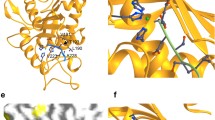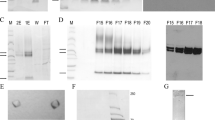Abstract
Tumour-necrosis factor-α (TNF-α) is a cytokine that contributes to a variety of inflammatory disease states1. The protein exists as a membrane-bound precursor2,3 of relative molecular mass 26K which can be processed by a TNF-α-converting enzyme (TACE), to generate secreted 17K mature TNF-α. We have purified TACE and cloned its complementary DNA. TACE is a membrane-bound disintegrin metalloproteinase. Structural comparisons with other disintegrin-containing enzymes indicate that TACE is unique, with noteable sequence identity to MADM4, an enzyme implicated in myelin degradation, and to KUZ5, a Drosophila homologue of MADM important for neuronal development. The expression of recombinant TACE (rTACE) results in the production of functional enzyme that correctly processes precursor TNF-α to the mature form. The rTACE provides a readily available source of enzyme to help in the search for new anti-inflammatory agents that target the final processing stage of TNF-α production.
Similar content being viewed by others
References
Vassalli, P. The pathophysiology of tumour necrosis factors. Annu. Rev. Immunol. 10, 411–452 (1992).
Decker, T., Lohmann-Matthes, M. L. & Gifford, G. E. Cell-associated tumor necrosis factor (TNF) as a killing mechanism of activated cytotoxic macrophages. J. mmuno. 138, 957–962 (1987).
Kriegler, M., Perez, C., DeFay, K., Albert, I. & Lu, S. D. A novel form of TNF/cachectin is a cell surface cytotoxic transmembrane protein: ramifications for the complex physiology of TNF. Cell 53, 45–53 (1996).
Howard, L., Lu, X., Mitchell, S., Griffiths, S. & Glynn, P. Molecular cloning of MADM: a catalytically active mammalian disintegrin-metalloprotease expressed in various cell types. Biochem. J. 317, 45–50 (1996).
Rooke, J., Pan, D., Xu, T. & Rubin, G. M. KUZ, a conserved metalloprotease-disintegrin protein with two roles in Drosophila neurogenesis. Science 273, 1227–1231 (1996).
Mohler, K. M. et al. Protection against a lethal dose of endotoxin by an inhibitor of tumor necrosis factor processing. Nature 370, 218–220 (1994).
Gearing, A. et al. Processing of tumor necrosis factor-α precursor by metalloproteases. Nature 370, 558–561 (1994).
Wolfsberg, T. G. & White, J. M. ADAMs in fertilization and development. Dev. Biol. 180, 389–401 (1996).
Gomis-Reuth, F. X. et al. Refined 2.0 angstrom x-ray crystal structure of the snake venom zinc-endopeptidase adamalysin II. Primary and tertiary structure determination, refinement, molecular structure and comparison with astacin, collagenase and thermolysin. J. Mol. Biol. 239, 513–544 (1994).
Van Wart, H. E. & Birkedal-Hansen, B. The cysteine switch: a principle of regulation of metalloprotease activity with potential applicability to the entire matrix metalloprotease gene family. Proc. Natl Acad. Sci. USA 87, 5578–5581 (1990).
Grams, F., Huber, R., Kress, L. F., Moroder, L. & Bode, W. Activation of snake venom metalloproteases by a cysteine switch-like mechanism. FEBS Lett. 335, 76–80 (1993).
Shannon, J. D., Baramova, E. N., Bjarnason, J. B. & Fox, J. W. Amino acid sequence of a Crotalus atrox venom metalloprotease which cleaves type IV collagen and gelatin. J. Biol. Chem. 264, 11575–11583 (1989).
Zhou, Q., Dangelmaier, C. & Smith, J. B. The hemorrhagin catrocollastatin inhibits collagen-induced platelet aggregatin by binding to collagen via its disintegrin-like domain. Biochem. Biophys. Res. Commun. 219, 720–726 (1996).
Gould, R. J. et al. Disintegrins: a family of integrin inhibitory proteins from viper venoms. Proc. Soc. Exp. Biol. Med. 195, 168–171 (1990).
Weskamp, G., Kratzschmar, J., Reid, M. S. & Blobel, C. P. MDC0, a widely expressed cellular disintegrin containing cytoplasmic SH3 ligand domains. J. Cell Biol. 132, 717–726 (1996).
Suffys, P., Beyaert, R., Van Roy, F. & Fiers, W. Involvement of a serine protease in tumor necrosis factor-mediated cytotoxicity. Eur. J. Biochem. 178, 257–265 (1988).
Bennett, T. A., Lynam, E. B., Sklar, L. A. & Rogelj, S. Hydroxamate-based metalloprotease inhibitor blocks shedding of L-selectin adhesion molecule from leukocytes. Functional consequences for neutrophil aggregation. J. Immunol. 156, 3093–3097 (1996).
Mullberg, J. et al. A metalloprotease inhibitor blocks shedding of the IL-6 receptor and te p60 TNF receptor. J. Immunol. 155, 5198–5205 (1995).
Arribas, J. et al. Diverse cell surface protein ectodomains are shed by a system sensitive to metalloprotease inhibitors. J. Biol. Chem. 271, 11376–11382 (1996).
Crowe, P. D. et al. A metalloprotease inhibitor blocks shedding of the 80-kD TNF receptor and TNF processing in T lymphocytes. J. Exp. Med. 181, 1205–1208 (1995).
Moyer, M., Rose, D. & Burkhart, W. Elutin of proteins from polyacrylamide gels onto the HP sequencing column. in Techniques in Protein Chemistry (ed. Crabb, J.) 195–204 (Academic, San Diego, 1994).
Granados, R. R., Guoxun, L., Derksen, A. C. G. & McKenna, K. A. A new cell line from Trichoplusia ni (BTI-Tn-5BI-4) susceptible to Trichoplusia single enveloped nuclear polyhedrosis virus. J. Invert. Path. 64, 260–266 (1994).
Ziegler-Heitbrook, et al. Establishment of a human cell line (Mono Mac 6) with characteristics of mature monocytes. Int. J. Cander 41, 456–461 (1988).
Morris, S. A. et al. Inhibition of organ invasion by the matrix metalloprotease inhibitor batimastat (BB-94) in two human colon carcinoma metastasis models. Cancer Res. 55, 3629–3633 (1995).
O'Byren, E. M. et al. Oral administration of a matrix metalloprotease inhibitor, CGS 27023A, protects the cartilage proteoglycan matrix in a partial meniscectomy model of osteoarthritis in rabbits. Inflam. Res. 44 (suppl. 2), S117–S118 (1995).
Author information
Authors and Affiliations
Rights and permissions
About this article
Cite this article
Moss, M., Jin, SL., Milla, M. et al. Cloning of a disintegrin metalloproteinase that processes precursor tumour-necrosis factor-α. Nature 385, 733–736 (1997). https://doi.org/10.1038/385733a0
Received:
Accepted:
Issue Date:
DOI: https://doi.org/10.1038/385733a0
- Springer Nature Limited
This article is cited by
-
Overexpression of transmembrane TNFα in brain endothelial cells induces schizophrenia-relevant behaviors
Molecular Psychiatry (2023)
-
Estradiol mitigates stress-induced cardiac injury and inflammation by downregulating ADAM17 via the GPER-1/PI3K signaling pathway
Cellular and Molecular Life Sciences (2023)
-
Sex-specific differences in cardiac function, inflammation and injury during early polymicrobial sepsis
Intensive Care Medicine Experimental (2022)
-
The Role of ADAM17 in Inflammation-Related Atherosclerosis
Journal of Cardiovascular Translational Research (2022)
-
Congenital iRHOM2 deficiency causes ADAM17 dysfunction and environmentally directed immunodysregulatory disease
Nature Immunology (2022)





